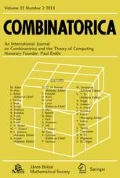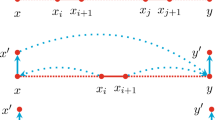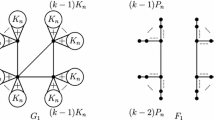Abstract
The fractional arboricity of a graph G, denoted by Γf (G), is defined as
. The celebrated Nash-Williams’ Theorem states that a graph G can be partitioned into at most k forests if and only if Γf (G)≤k. The Nine Dragon Tree (NDT) Conjecture [posed by Montassier, Ossona de Mendez, Raspaud, and Zhu, in “Decomposing a graph into forests”, J. Combin. Theory Ser. B 102 (2012) 38-52] asserts that if
, then G decomposes into k+1 forests with one having maximum degree at most d. In this paper, we prove the Nine Dragon Tree (NDT) Conjecture.
Similar content being viewed by others
References
J. Balogh, M. Kochol, A. Pluhár and X. Yu: Covering planar graphs with forests, J. Combin. Theory Ser. B 94 (2005), 147–158.
P. A. Catlin, J. W. Grossman, A. H. Hobbs and H.-J. Lai: Fractional arboricity, strengh and principal partitions in graphs and matroids, Discrete Math. Appl. 40 (1992), 285–302.
M. Chen, S. Kim, A. Kostochka, D. B. West and X. Zhu: Decomposition of sparse graphs into forests: the Nine Dragon Tree Conjecture for k≤2, preprint, 2014.
G. Fan, Y. Li, N. Song and D. Yang: Decomposing a graph into pseudoforests with one having bounded degree, J. Combin. Theory Ser. B 115 (2015), 72–95.
S. L. Hakimi: On the degree of the vertices of a directed graph, J. Franklin Inst. 279 (1965), 290–308.
D. Gonçalves: Étude de diffèrents problemes de partition de graphes, thesis, Universitè Bordeaux 1, 2006.
D. Gonçalves: Covering planar graphs with forests, one having bounded maximum degree, J. Combin. Theory Ser. B 99 (2009), 314–322.
S.-J. Kim, A. V. Kostochka, D. B. West, H. Wu and X. Zhu: Decomposition of sparse graphs into forests and a graph with bounded degree, J. Graph Theory 74 (2013), 369–391.
M. Montassier, P. Ossona de Mendez, A. Raspaud and X. Zhu: Decomposing a graph into forests, J. Combin. Theory Ser. B 102 (2012), 38–52.
C. St. J. A. Nash-Williams: Decompositions of finite graphs into forests, J. London Math. Soc. 39 (1964), 12.
C. Payan: Graphes equilibre et arboricitè rationnelle, European J. Combin. 7 (1986), 263–270.
J.-C. Picard and M. Queyranne: A network ow solution to some nonlinear 0-1 programming problems, with applications to graph theory, Networks 12 (1982), 141–159.
D. Yang: Decompose a graph into forests and a matching, manuscript, 2014.
X. Zhu: Game coloring number of planar graphs, J. Combin. Theory Ser. B 75 (1999), 245–258.
Author information
Authors and Affiliations
Corresponding author
Additional information
Supported in part by NSFC under grant 11471076.
Rights and permissions
About this article
Cite this article
Jiang, H., Yang, D. Decomposing a Graph into Forests: The Nine Dragon Tree Conjecture is True. Combinatorica 37, 1125–1137 (2017). https://doi.org/10.1007/s00493-016-3390-1
Received:
Revised:
Published:
Issue Date:
DOI: https://doi.org/10.1007/s00493-016-3390-1
Key words and phrases
- decomposition of a graph
- arboricity
- fractional arboricity
- Nash-Williams’ Theorem
- Nine Dragon Tree (NDT) Conjecture




